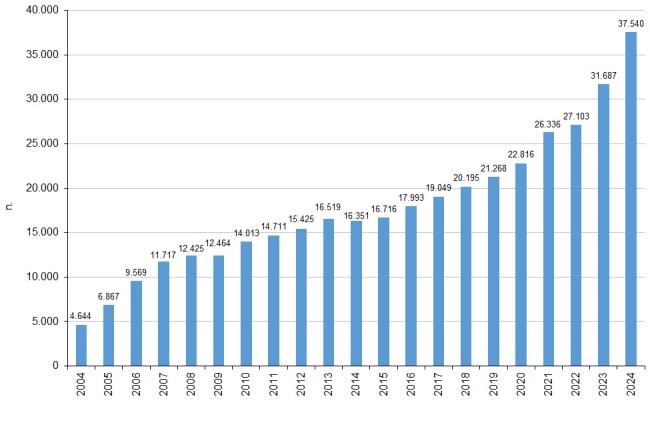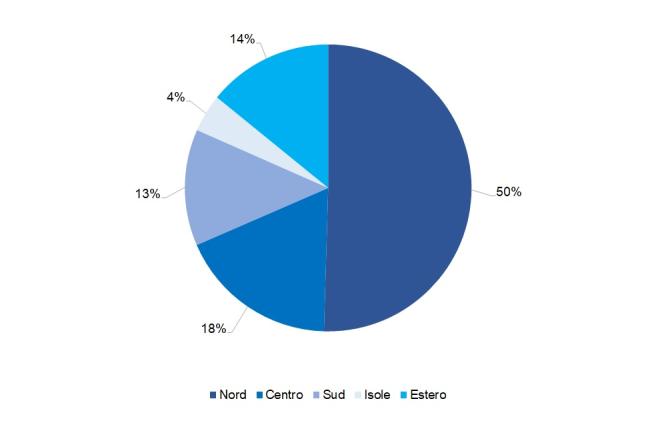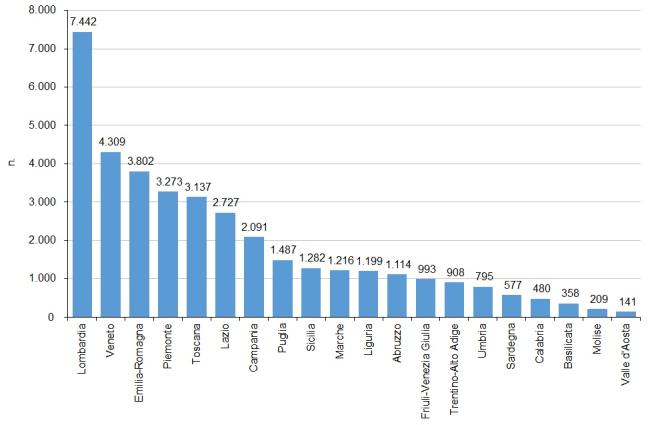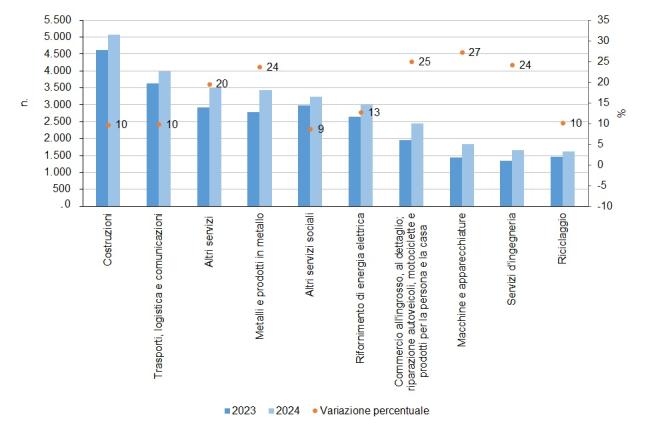Panel 1
Alessandro Nisi, Francesca Nizzero
The indicator refers to company sites with an environmental management system compliant with the UNI-EN-ISO 14001 standard, certified by a body accredited by ACCREDIA, which attests to the body’s competence and independence in accordance with relevant international standards. As of the end of 2024, there are 37,540 Italian company sites holding a valid certification, marking a significant increase compared to 2023 (31,687). Half of the certified companies are located in the northern regions of Italy, with Lombardy leading in the number of certifications, accounting for 7,442 company sites with a management system conforming to UNI-EN-ISO 14001.
In addition to Italian company sites, a substantial share of foreign enterprises—representing 14% of the total—have also certified their environmental management systems.
The economic sectors with the highest adoption rates of certification are “Construction”, “Transport, logistics and communications”, and “Other services”, with 5,075, 3,994 and 3,484 certified company sites, respectively.
The number of UNI-EN-ISO 14001 certificates can be considered an indicator of the environmental awareness of companies and organisations, which, through a certified environmental management system, aim to manage and reduce the environmental pressures resulting from their activities.
A widespread implementation of environmental management systems reflects a degree of responsiveness to the issue of sustainable development, ultimately benefiting environmental quality.
The number of certificates indicates how many organisations have achieved these objectives and therefore meet the requirements set out in the relevant standard (UNI-EN-ISO 14001).
The certification process involves third-party and independent assessment by an accredited certification body, whose competence, independence, and impartiality have been verified by ACCREDIA. This ensures the impartiality of the evaluations carried out and the reliability of the certifications issued to companies and organisations.
The information provided by this indicator should thus be interpreted as a response to the pressures and impacts generated by pollution from production activities.
The environmental benefits resulting from the adoption of UNI-EN-ISO 14001 certification mainly include: prevention or reduction of environmental impacts; reduced use of raw materials and energy in business processes; reduction of emissions or waste; and improved environmental performance through management and/or technological and infrastructural objectives.
o offer a concise overview of the degree of environmental awareness and commitment demonstrated by organisations and enterprises, across both the public and private sectors.
-
UNI-EN-ISO 14001:2015 Environmental Management Systems – Requirements with Guidance for Use
-
Legislative Decree of 31 March 2023, No. 36 – so-called “Public Procurement Code”, Article 57
The Public Procurement Code has established that Green Public Procurement (GPP) is a mandatory instrument at all administrative levels, requiring the inclusion of Minimum Environmental Criteria (CAM – Criteri Ambientali Minimi, specific to product categories and adopted through various decrees by the former Ministry for Ecological Transition, now MASE) within public tender documents.
No predetermined target, as this is a voluntary scheme.
Panel 2
- Accredia - Prometeia (2020). Accreditamento e certificazioni. Valore economico e benefici sociali
- Accredia - Scuola Superiore Sant'Anna (2018). L’Economia Circolare nelle politiche pubbliche. Il ruolo della certificazione
- CESQA, Accredia (2018). Benefici, costi e prospettive del sistema di gestione ambientale: Indagine presso le organizzazioni italiane certificate ISO 14001. Edizione 2018
- Norma tecnica UNI-EN-ISO 14001: 2015
Symbola - Accredia – Cloros (2016). Certificare per competere. Dalle certificazioni ambientali nuova forza al Made in Italy - Testa, F., Rizzi, F., Daddi, T., Gusmerotti, N. M., Frey, M. and Iraldo, F. (2014). EMAS and ISO 14001: the differences in effectively improving environmental performance. Journal of Cleaner Production, 68, 165-173
The data relating to the number of organisations with an environmental management system certified in accordance with UNI-EN-ISO 14001 are collected and updated by ACCREDIA.
They refer exclusively to certifications issued by certification bodies accredited by ACCREDIA under the EMS (Environmental Management Systems) scheme.
Indicator development for the analysis of certification flows, in terms of the ratio between newly certified organisations under UNI-EN-ISO 14001 and organisations that are no longer certified.
Data quality assessment
ACCREDIA (L’Ente Italiano di Accreditamento)
Data on UNI-EN-ISO 14001 certificates are provided in real time to ACCREDIA (the Italian Accreditation Body) by all certification bodies accredited to issue UNI-EN-ISO 14001 certifications and are accessible through a dedicated platform (https://www.accredia.it/banche-dati/).
National, regional
2004-2024
Indicator assessment
The number of company sites certified to UNI-EN-ISO 14001 by an ACCREDIA-accredited certification body is considered.
In 2024, the indicator records an 18% increase compared to the previous year, raising the number of Italian production sites with an environmental management system certified in accordance with the UNI-EN-ISO 14001 standard from 31,687 to 37,540 (Table 1 and Figure 1).
Specifically, the sectors showing the highest percentage growth are: “Machinery and equipment” with 27%, “Wholesale and retail trade; repair of motor vehicles, motorcycles, and personal and household goods” with 25%, and tied for third place, “Metals and metal products” and “Engineering services” both with 24% (Figure 4).
Accredited certification of an environmental management system represents a competitive advantage for companies, both through improved organisational efficiency and through enhancement of their corporate image.
It is no coincidence that the area with the highest number of production sites certified to UNI-EN-ISO 14001 is the North, accounting for 50% of the total, followed by the Central regions (18%), the South and Islands (13% and 4%, respectively), and foreign countries (14%) (Figure 2).
The number of organisations with an environmental management system certified under accreditation according to the UNI-EN-ISO 14001 standard has steadily increased over the past 10 years (Figure 1).
Data
Table 1: Evolution of the Number of UNI-EN-ISO 14001 Certifications by Region
ACCREDIA
The certification data refer to company/production sites with a certified UNI-EN-ISO 14001 management system. A site may correspond to an office, a production unit, or a department of the certified company. Multiple certified sites may belong to a single certified company
ACCREDIA
The certification data refer to company/production sites with a certified UNI-EN-ISO 14001 management system. A site may correspond to an office, a production unit, or a department of the certified company. Multiple certified sites may belong to a single certified company
Figure 2: Percentage distribution of UNI-EN-ISO 14001 certifications by geographical area (2024)
ACCREDIA
The certification data refer to company/production sites with a certified UNI-EN-ISO 14001 management system. A site may correspond to an office, a production unit, or a department of the certified company. Multiple certified sites may belong to a single certified company
ACCREDIA
The certification data refer to company/production sites with a certified UNI-EN-ISO 14001 management system. A site may correspond to an office, a production unit, or a department of the certified company. Multiple certified sites may belong to a single certified company
Figure 4: Top Ten Economic Sectors by Number of UNI-EN-ISO 14001 Certifications with Percentage Change (2024)
ACCREDIA
The certification data refer to company/production sites with a certified UNI-EN-ISO 14001 management system. A site may correspond to an office, a production unit, or a department of the certified company. Multiple certified sites may belong to a single certified company




The European Green Deal has outlined a pathway for sustainable growth that businesses and policymakers must follow to achieve the established goal of climate neutrality by 2050. Within this framework, public policies find in Green Public Procurement (GPP) a key lever to support the transition towards a new sustainable economic model. Indeed, it is also through the demand for sustainable products and services that the Public Administration can influence the market.
In particular, the Public Procurement Code (Legislative Decree 31 March 2023, No. 36) confirms the mandatory application of the Minimum Environmental Criteria (CAM) in all public procurement procedures concerning services, products, and works for which relevant decrees have been issued. Accredited conformity assessments, including certifications under UNI-EN-ISO 14001 frequently referenced within the CAM, constitute a valuable policy tool to ensure public actions are efficient and aligned with established objectives.
The growing awareness of environmental issues among businesses has led to a wider adoption of certifications and labels that attest to the sustainability of their activities. Well-established and market-recognised tools such as UNI-EN-ISO 14001 certifications, issued by accredited certification bodies, are an important differentiating factor for adopters.
The increasing trend in the number of company sites with a certified environmental management system aligns with this context, though there remains considerable scope for further diffusion of UNI-EN-ISO 14001 certification.
As of 31 December 2024, the number of Italian company sites certified by an accredited certification body is 37,540 (Table 1 and Figure 1). The highest concentration of certified companies is in the northern regions (Figure 2), particularly Lombardy (7,442 certified company sites), Veneto (4,309), and Emilia-Romagna (3,802) (Figure 3). A substantial share (14%) of certified companies are foreign enterprises certified by certification bodies accredited by ACCREDIA (Figure 2).
Among the top 10 sectors with the highest concentration of certified environmental management systems, “Construction” remains in first place with 5,075 certified sites, followed by “Transport, logistics and communications” with 3,994, and “Other services” with 3,484 (Figure 4).